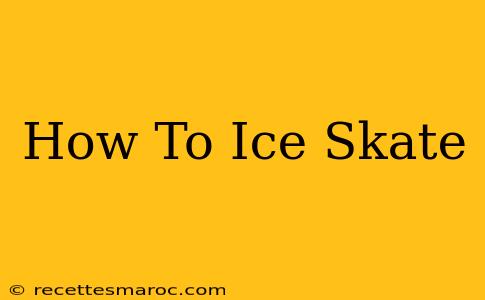So, you're ready to hit the ice? Ice skating is a fantastic winter activity, a graceful dance on the frozen surface, and a fantastic workout! Whether you're a complete beginner or looking to brush up on your skills, this guide will walk you through the essentials of how to ice skate.
Getting Started: Gear Up!
Before you even think about gliding across the rink, you need the right gear. This isn't just about looking the part; proper equipment ensures your safety and comfort.
Essential Ice Skating Gear:
- Skates: Rental skates are readily available at most ice rinks, but for serious skaters, investing in your own pair is worthwhile. Make sure they fit snugly but not too tight.
- Warm Clothing: Layers are key! Dress warmly in thermal underwear, sweaters, and a warm jacket. Don't forget gloves or mittens, a hat, and warm socks.
- Helmet (Highly Recommended): Especially for beginners, a helmet is crucial for protecting your head from falls. Safety first!
Mastering the Basics: Your First Steps on Ice
Stepping onto the ice for the first time can be daunting, but with a few basic techniques, you'll be gliding in no time.
Finding Your Balance:
- Wide stance: Begin by standing with your feet shoulder-width apart, knees slightly bent. This wide stance provides stability.
- Relaxed posture: Keep your back straight and shoulders relaxed. Avoid hunching over.
- Weight distribution: Distribute your weight evenly between both feet.
- Gentle bends: Use slight bends of your knees to absorb shocks as you move.
Getting Moving:
- The "penguin walk": Start by walking on the ice, using small, controlled steps. This helps you get a feel for the ice.
- Marching: Once you feel more comfortable, try marching, lifting your knees slightly higher with each step.
- Gliding: Slowly transition to gliding. Instead of lifting your feet entirely, try pushing off with one foot and gliding on the other.
Improving Your Technique: From Beginner to Confident Skater
Once you've mastered the basics, it's time to refine your technique and work on more advanced skills.
Forward Skating:
- Proper push-off: Push off with the inside edge of your skate, using a strong, controlled motion.
- Smooth transitions: Aim for smooth, continuous glides between each push-off.
- Consistent speed: Gradually increase your speed as you become more comfortable.
Stopping:
- Snowplow stop: This is the most common stopping technique for beginners. Slightly turn your feet outward and create a "V" shape with your skates. Apply pressure to the outer edges of your skates to slow down.
- Hockey stop: This more advanced technique involves turning your skates sideways and digging the edges into the ice to abruptly stop.
Turning:
- Gentle turns: Start with gentle turns by shifting your weight slightly from one foot to the other.
- Controlled curves: Practice creating smooth, controlled curves on the ice.
Beyond the Basics: Advanced Ice Skating Skills
As your confidence and skills grow, you can explore more advanced techniques such as:
- Spinning: Learn different types of spins, from simple forward spins to more complex variations.
- Jumps: Jumping on ice skates requires significant skill, balance, and strength. This is best learned with professional instruction.
- Figure skating: Figure skating involves precise movements, complex footwork, and graceful transitions.
Staying Safe on the Ice:
- Warm-up: Always warm up before you start skating to prevent injuries.
- Listen to your body: Take breaks when you need them. Don't push yourself too hard.
- Be aware of your surroundings: Pay attention to other skaters on the ice and avoid collisions.
Ice skating is a rewarding experience that improves balance, coordination, and fitness. With practice and patience, you'll be gliding across the ice with confidence and grace. So get out there, have fun, and enjoy the ride!

